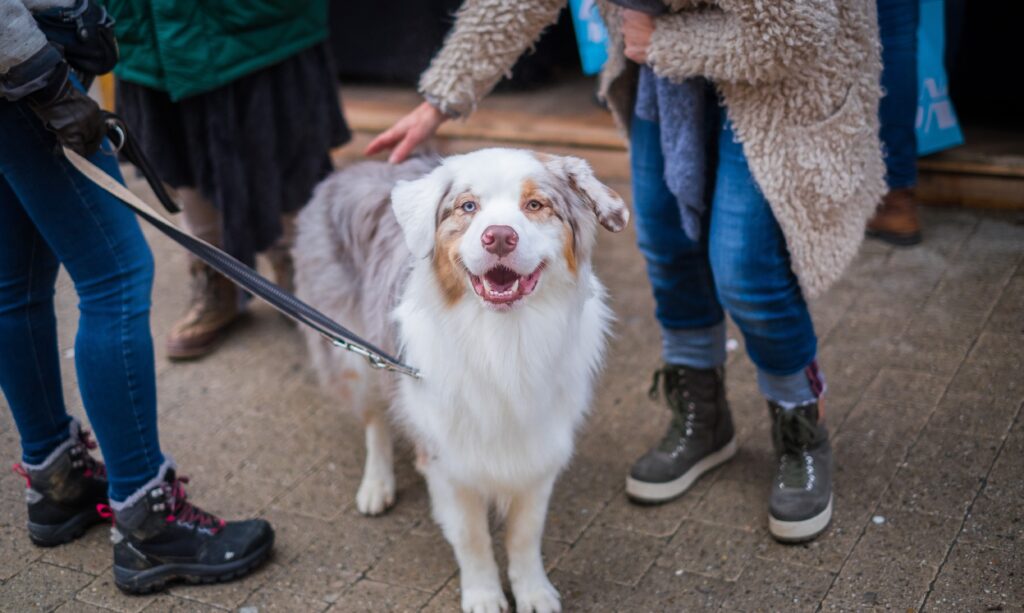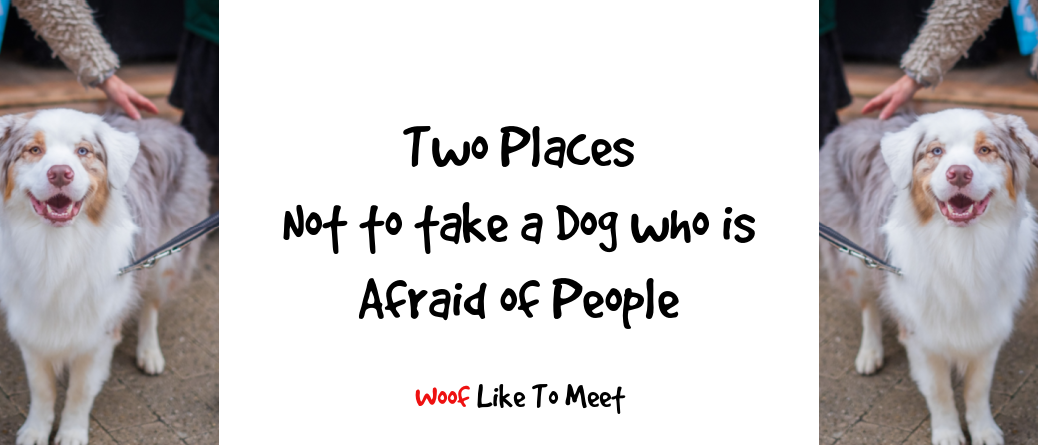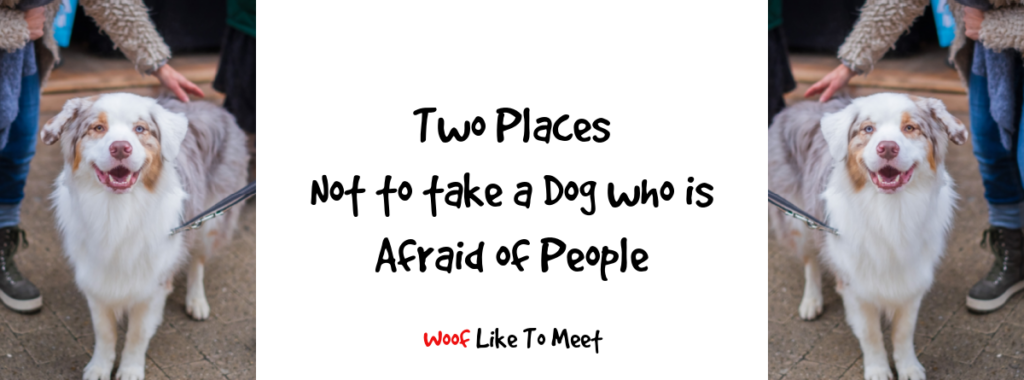* At least until they’re really well and truly ready for it…
One comment that strikes the fear of God into me when I hear people talking about their new rescue dog is “I’ve been taking him to the market to socialise him.”
This is closely followed by my fear of comments saying, “I’ve been taking him to cafés to socialise him.”
What this generally means is that the new guardians have noticed that their dog is a little wary of people and they’ve decided to do something to show their dog that there’s nothing to be afraid of. We don’t even think to try to socialise a dog who’s already social.

We’d all very much like a dog like this splendid guy and we think that exposure to markets and cafés will help them. The trouble is that nobody says they’re talking a relaxed and friendly dog like this to market to ‘socialise’ them.
Worse is when I hear this comment within days of arrival, when the dog is no doubt still adjusting to their new life. Sadly, it often happens with dogs who’ve been adopted into a world that asks them to make a huge cultural shift, like being adopted from an isolated rural working life into a life of sociable, urban, retired people who want a dog who’s a companion rather than a tool.
I know these actions are well meant. I know every single guardian who’s ever embarked on taking their dog to a market or a café is trying to help their dog. However, there are two fundamental misconceptions that could lead to a deterioration in behaviour, or, worse, a bite.
The First Misconception
The first misconception is that we can ‘socialise’ an adult dog. Sorry. That boat has largely sailed around the 14-week mark. What you are doing is remedial socialisation. Or, at least, that’s what you’re hoping for. You’re hoping to fill in the early learning gaps that have left your dog feeling less than confident around humans.
Like any corrective event, you’re working against initial learning which is always and without question the most profound learning. There’s even some debate about whether we can actually ‘unlearn’ what we already know. So you’re not just hoping to teach your dog, you are trying to ‘unlearn’ and ‘reteach’.
Our early learning is arguably the learning which sets the rules. Either we learn that people are lots and lots of fun, and not scary at all, or we learn that people are scary. We might also learn very little about people – and that hurts our dog’s development too. Very often when people tell me their dog is scared of children, it’s more that their dog has never met children.
What we know about learning is that the first experiences probably define the rules. That dog in the photo? His initial experiences between 6-14 weeks will have been that people are harmless and even kind of fun. I don’t even need to know this dog to know that’s what he’ll have learned.
Everything after those first experiences – including remedial learning – is about learning exceptions.
So you’ve got a dog who, for whatever reason, either doesn’t understand people or is afraid of people. That’s their rule. People are scary. If you keep taking them to places which are scary, that’s just confirming the rule they already understand. Yep. Those people. They’re scary too. And, if you’re their guardian, if you keep putting them in scary situations, well, people are still scary and now you’re not very trustworthy either.
I’d argue that every single carefully-constructed positive social experience where we’re consciously, carefully, thoughtfully exposing them to their triggers is where the animal is learning, “People are scary. Okay, not that person.”
“People are scary. Okay, not them.”
“People are scary except those ones. Okay, not them, either.”
Notice that I said every single positive social experience. If it’s a bad experience – even just because the dog feels afraid – then it just confirms the rule.
“I was right after all! People are scary!”
Don’t forget either that for some breeds or mixes of dogs, their innate, default position – the one they have before they’re even born – is that people are scary. If you’ve a fancy for dogs whose kennel club breed standard says things like “aloof” or “loyal”, if they’re the kind of breed that people say, “Oh he’s lovely when you get to know him!” then they’re often bringing a preset package of suspicion into the mix. Any dog bred for protective qualities – from small lapdogs up to big livestock guardian dogs – comes with that default setting too. Early and appropriate socialisation before 14 weeks just helps them modulate how scary they think strangers are.
When we do remedial socialisation, we have one aim: to help dogs feel relaxed around humans. We’re aiming for hundreds (yes, really!) of experiences where they’re learning, “Okay, not that one… okay, not that one… okay, not that one…”
There will be days when you’ll wonder if they’ve fully generalised that new rule. People are not scary. One day – maybe six months in, maybe a year, maybe two – you’ll wonder if they’ve got it. Maybe, just maybe, they’ve finally learned that 8 billion people are not scary and you won’t have to introduce them to each and every one of them in a carefully controlled and constructed ways.
“Wonderful!” you’ll think. “They’ve got it!”
On those days, I practically guarantee that the very next day, your dog will remind you that the rule is SCARY and there are a limited number of acceptable exceptions.
Make no mistake about it, we’re unlikely to turn our spooky dog into a social butterfly. That dog in the photo? Well, your dog is probably never going to look like he does. Sorry about that.
That’s the first misconception: we’re not socialising our dogs. Our adult dogs are not being socialised when we take them to market. You don’t need to treat your adult dog (or your puppy) to a ticklist of situations. I hate those ticklists. I especially hate ticklists that circulate on social media. You know – the ones that say to go to a café, a bus station, a train station, a supermarket, the town dump, a church service, a wedding service, a funeral. If you’re going to a funeral, make sure you go to ones with people in black. Take them to a mosque and a temple and a synagogue and make sure they’re used to a djellaba and a burnous and a person in harem pants. Neither initial experiences of humans nor remedial experiences are a check list.
If we get lucky with our pups and they’re used to it, you’ll be able to take your dogs to scary social events and they’ll be blasé about stilt walkers and fire-eaters and dagger throwers, clowns, apothecaries and knights in shining armour. What we’re aiming for is a dog whose general rule is that people are weird, and harmless but not scary and their exception of, ‘Ok, not that one… he was harmful and scary!’ doesn’t become the general rule.
With a dog whose general rule is either that they find people scary or they don’t know people at all, we’re working against the current. At best then, what we’re hoping for is remedial education that helps them find many exceptions to rules they’ve already learned.
The Second Misconception
The second misconception people make in trying to solve fearfulness by going to busy venues relates to the hope that dogs will learn people are great if we fully immerse them in such situations. What usually happens is the dog is flooded. You can read about flooding here. Because they’re on the lead and because we’re often in places where there aren’t many places to escape because there are small alleyways, tables, stands, people and so on, the dog is subjected to an inescapable situation. They are unable to get away.
Because they are unable to get away, we’ve effectively removed their ability to escape. That means we’ve left them with few options. One is to become obsequiously and obnoxiously friendly. I know. You’re thinking this is a good thing. I see it as a coping mechanism used by a lot of dogs whose guardians think that the dog is really sociable. Another option is to just shut down. There’s a difference between dogs who’ve chosen freezing as an option compared to having given up, but if you’ve ever been under the beady eye of a teacher looking for a volunteer and you’ve chosen stillness in the hopes that they’ll not notice you or pick on you, then you’ve used freezing yourself as a behaviour choice under duress. Other dogs get restless and fidgety. They move more, seem agitated and seem to be looking for comfort more. I notice these dogs panting a lot or offering quite a lot of behaviours to get their guardian’s attention. Other dogs shut down or cower. They try to make themselves as small as possible.
And yes, of course, there are the dogs who growl, bark, snarl, lunge, snap or bite. That’s sometimes the only solution we leave our dogs with. Sadly, I know a lot of dogs who’ve felt the need to do this when grabby hands approach, and let me tell you, it’s one form of learning you don’t want your dogs to become familiar with.
It’s invariably those people who say, “Oh dogs just love me!” who crowd our dogs, shove their hands into the dog’s face and then end up getting a warning bite. Never take your dog to a place of professed dog lovers. Take them around professionals who see dogs all day every day and won’t even try to pet your dog. Or take them around people who are not interested in dogs at all. But don’t take them to see your friends who tell you that all dogs love them or that they just love dogs. Those people will try to grab your dog. I know. I am that person. I have to physically restrain myself. It takes a lot of willpower.
I find as well that some people say, “Oh, market works for me! My dog copes better with people up close and lots of them than they do with one or two people on the horizon.”
What is generally happening in these circumstances is that the dog is absolutely not okay with people but because there are people everywhere, they’ve no choice but to kind of suck it up. The problem is that this often leads to a dog shutting down, seeming to cope, trigger stacking and then having a bit of a meltdown when something pushes them over the edge. I see these dogs slinking around markets being ‘socialised’ by guardians who unfortunately don’t realise that their dog is one step away from that meltdown.
Believing in full immersion for ‘treatment’ is the second misconception. It’s really important that we understand this is not therapeutic but is very likely to go wrong. Even human therapies from fears, with adults who can sign up with informed consent to conquer fears and phobias do not work on full immersion. Full immersion is what we see on fictional crime shows where the villain is a therapist gone wrong. It’s what we see on news reports about practitioners who’ve been struck off. It’s the worst practice from the past – practices that now make us sick to our stomach to realise what we made people endure in the hopes of ‘curing’ them. We shouldn’t be doing it with animals who don’t understand what is happening to them. Throwing them in at the deep end is no way to teach them how to swim.
What to do instead
If you’ve got a dog who’s skittish around people and you really want to make a difference, there are a few simple tips to help you.
The first is to choose a place where you can control what people are doing and how close they will come. I’m a big fan of working right at the very back of supermarket car parks where there’s regular comings-and-goings, and starting at a quiet time. That only works, of course, if your dog is okay with cars coming and going, and with things like trolleys. Often, dogs who have limited experiences of humans have limited experiences of other things too, which can make it more complicated. Industrial estates are also great. People who are working, who are often in yards or busy doing stuff aren’t going to drop their stuff and come to see you.
The weather is also your friend if your dog is happy in the rain. Get your coat on and go out in the rain and I guarantee there’ll be fewer people and nobody will want to stop to pet your dog, especially if you’re at a distance.
I’m a fan of using natural see-through or see-over barriers other than fences. Fences can be okay, but sometimes they can cause more problems than they resolve. Roads and rivers are great. If your dog is okay with moving traffic, having a busy-ish road between you and a bunch of people can be an easy solution. For instance, one local supermarket has a busy road leading into it and a barren bit of wild, empty space opposite. We go and work on there. People don’t tend to cross that busy road and nobody wants to come into a dirty bit of unkempt green space. Another favourite is a playground just on the opposite bank of a river. We can see the children, but they’d have to get through a very wide river to come and pet us. Industrial estates, docks, ports and warehouses can also be great. Wherever people are doing a job and in a nice, secure area, you’re very able to go and do a bit of stealth training at a distance.
When I know an area really well, I’ll also stalk local hikers and ramblers groups. When you know they’ll all be meeting up at 8.30 and setting off at 9am from a particular car park or train station, you’ve got a very good timetable for when there are going to be people at a distance and you can work a good distance away from them. That’s especially true if you can put a road or river between them and you as well. I keep an eye on the ramblers’ groups and go and do a bit of work at a safe distance from their meeting venue. If your dog is happy and comfortable, you can even follow them a little way for increased exposure. In general, though, I work on the principle that five minutes is actually more than enough. Finish on a win and never be tempted to push it too far.
What I’m aiming for is for my dog to see people loads and loads of times without any single thing happening. Nobody approaches them. Nobody tries to touch them. Nobody crowds them. Nobody is ever nearer than at least 20m (more if necessary). My eyes pop when people are within a metre of loads of bare legs in shorts at a summer market, hoping their dog is socialising. Even more joyous are those bare legs in among loads of tables and dropped food morsels in a café. I once watched a lady trying to ‘socialise’ her Tervuren at a street market where the dog was grabbing people’s bags and lunging at passers-by. Well-meaning but not educative, that’s for sure.
No cafés. No bare legs. No grabby hands. No people who think dogs love them. No markets. Not for fearful adult dogs. Not even quiet cafés and quiet markets.
All these scenarios are what I call Final Boss level.
You know in conflict video games where you start fighting the easy villains? You’re cutting your teeth on those who are easy to defeat. As you go on through each level of the game, the villains get harder and harder. But you’ve got better and better. In each prior level, you’ve learned skills that help you beat the baddies on the levels that lie ahead. Final boss level is the ultimate challenge. The Goliaths to your David.
If you haven’t done all the levels before, you’re going to be chopped into tiny morsels before you’ve found out how to even wave your sword about. Game over.
But as you’ve gone through the game, you’ve got so good that the villains on level 1 are out for the count within a few swift strokes.
Markets and cafés are Final Boss level for a fearful dog.
Plan out your challenges. Start with something so easy you know your dog will ace it. 1 person for 1 second at 200m.
And as you increase your levels, keep two of the factors the same while you make the third more challenging. 2 people for 1 second at 200m. 2 people for 2 seconds at 200m.
Keep it so easy that you’d put money on your dog winning the challenge.
Will they be able to do 200 people for 30 minutes at 1 metre eventually? Maybe, if you put enough of the right work in. I accidentally ended up with one of my dogs in the middle of a Venetian carnival parade complete with cloaked plague doctors. Life definitely gets in the way of best laid plans! My dog is a bit fearful of people, but he coped. We’d done a lot of work to get to that point.
But when your dog is ready for it, medieval carnivals with bands, stilt walkers, musicians, acrobats and flamethrowers are not beyond their grasp. It’s just… they’re Final Boss level and your dog hasn’t passed level 1 yet. And, as far as dogs are concerned, markets are no different than medieval carnivals. They’re just as wild, unpredictable, foreign, bizarre, frightening and potentially dangerous. Just because we understand markets are safe doesn’t mean dogs do.
But do we start with the Venetian carnival parades complete with cloaked plague doctors?
Not if we want our dogs to cope.
Many people want to know how long it will take to go from scared to social. It’s impossible to say how long that will take, but one thing is for sure – it won’t happen in a couple of weeks.
In general, I work with dogs for 5-10 minutes every couple of days. We rest. We have time to reconsolidate our understanding of things. We play. We sleep. We keep it short and sweet and we always finish on a win. Depending on the severity of the behaviour, most dogs seem to get there within three to six months. Some are helped enormously by medication alongside that programme. If you think it will take longer than six months, even if you make sure there are no great leaps between each level, then I’d say asking the vet if there’s anything you can do to help and considering nutraceuticals if not pharmaceuticals should definitely be something to think about.
But it all depends. I don’t have time to do this with my own dogs. We do a lot of stealth and accidental training. It’s slower, but that’s fine. I don’t have a need for my dogs to cope with Mardi Gras in Rio. I don’t want to take them to cafés and I don’t ever want to walk them through a market.
It also depends on the dog and what you’re doing with them. Some dogs have such holes in their socialisation, they’ve practised behaviour for so long, they’re breeds who are especially suspicious of trainers. They’re the kind of dog I do a lot of scaffolding around and a lot of support. Other dogs, like one of mine, don’t need that same support and it can backfire, accidentally sensitising them or making the people significant. Just as an example, my boy is not car-sensitive at all. He’s lived on a main road all his life and we walk around cars all the time. They’re just not even salient things to him. They’re as insignificant as stones. But my old girl Flika was sensitive to cars. There was some quite embarrassing behaviour from a senior girl. Once, she ran off and got in a tractor to my unparalleled shame. So we did a bit of work around them. But because my boy was always with us when we did, he paired those cars up with the fact we’d stop, play games, do stuff, eat things… and soon he came to anticipate those cars when he never had before. They were always a source of delight, because treats came out, but nevertheless, there was a turn of the head and a brightening of the eyes that said, “Hey, did you see that?”
This, though, is a post of its own and for that reason I’ll be discussing what kind of training I might do with different kinds of dogs in the next post.
Because there are so many subtleties, however, it’s primordial you work with a good trainer who can help you through. If you need someone to coach you or to give you a few tips about how to help your dog master each level, a trainer can definitely help you with that! Having good intentions is amazing. With the right know-how, you can make a real difference to the quality of your dog’s life and broaden their horizons in a safe and nonthreatening way.




